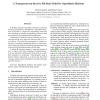Free Online Productivity Tools
i2Speak
i2Symbol
i2OCR
iTex2Img
iWeb2Print
iWeb2Shot
i2Type
iPdf2Split
iPdf2Merge
i2Bopomofo
i2Arabic
i2Style
i2Image
i2PDF
iLatex2Rtf
Sci2ools
IPPS
2008
IEEE
2008
IEEE
A transparent non-invasive file data model for algorithmic skeletons
A file data model for algorithmic skeletons is proposed, focusing on transparency and efficiency. Algorithmic skeletons correspond to a high-level programming model that takes advantage of nestable programming patterns to hide the complexity of parallel/distributed applications. Transparency is achieved using a workspace factory abstraction and the proxy pattern to intercept calls on File type objects. Thus allowing programmers to continue using their accustomed programming libraries, without having the burden of explicitly introducing non-functional code to deal with the distribution aspects of their data. A hybrid file fetching strategy is proposed (instead of lazy or eager), that takes advantage of annotated functions and pipelined multithreaded interpreters to transfer files in-advance or on-demand. Experimentally, using a BLAST skeleton application, it is shown that the hybrid strategy provides a good tradeoff between bandwidth usage and CPU idle time.
Algorithmic Skeletons | Distributed And Parallel Computing | Hybrid file Fetching | IPPS 2008 | Nestable Programming Patterns |
| Added | 31 May 2010 |
| Updated | 31 May 2010 |
| Type | Conference |
| Year | 2008 |
| Where | IPPS |
| Authors | Denis Caromel, Mario Leyton |
Comments (0)

